A User's Manual for DELSOL3 - prod.sandia.gov - Sandia National ...
A User's Manual for DELSOL3 - prod.sandia.gov - Sandia National ...
A User's Manual for DELSOL3 - prod.sandia.gov - Sandia National ...
Create successful ePaper yourself
Turn your PDF publications into a flip-book with our unique Google optimized e-Paper software.
VI. Program Flow<br />
DELSOL can be used in two ways: to do a detailed per<strong>for</strong>mance calculation<br />
<strong>for</strong> a system which is completely defined by the user, or to define by optimization<br />
a system having a lowest energy cost and then do a detailed per<strong>for</strong>mance calcu-<br />
lation on that system. For the first case, no optimization, annual energy calcula-<br />
tion, or system cost calculations are done. Heliostat field zoning and zone helio-<br />
stat densities must be specified, along with desired receiver and tower dimensions.<br />
In fact, every default variable in the BASIC, FIELD, HSTAT, REC, and NLEFF<br />
Namelists should be examined 'to verify that the proper system is being examined.<br />
Even then, no energy calculations will be done, and no costs will be assigned to<br />
the system, but only field efficiencies and flux densities will be calculated. A user<br />
defined system should be examined by specifying IPROBf4 (Namelist BASIC)<br />
and IUSERF-2 or 3 (Namelist FIELD).<br />
The most useful function of DELSOL, that of finding an optimum system de-<br />
sign, has three calculational steps and several minor steps. The main steps are<br />
to do an initial per<strong>for</strong>mance calculation, to optimize several variables using the<br />
results from the initial per<strong>for</strong>mance calculation, and to do a final per<strong>for</strong>mance cal-<br />
culation on the optimum system. These steps fit into the list of actions suggested<br />
<strong>for</strong> optimization in Table VI-1.<br />
He<strong>for</strong>e any calculations are done, the user must still take the time and ef<strong>for</strong>t<br />
to see that the DELSOL defaults describe the proper system. Specification of the<br />
site, field boundaries, heliostat design, and receiver type are generally straight-<br />
<strong>for</strong>ward. However, determining receiver thermal losses and system costs can be<br />
much more involved. The radiation and convection losses depend on receiver ge-<br />
ometry, receiver material, temperature, and ambient conditions. The system costs<br />
depend on the technology and applications. Detailed cost estimation may be re-<br />
quired to generate the input to DELSOL. In addition to the direct capital costs,<br />
operating and maintenance costs must be estimated. Finally, the economic pa-<br />
rameters suitable <strong>for</strong> the intended application of the system have to be specified.<br />
The initial per<strong>for</strong>mance calculation is required as a first step <strong>for</strong> optimiz-<br />
ing a system design, since the results will be scaled to give the per<strong>for</strong>mance of<br />
the different systems in searching <strong>for</strong> the optimum design. The specifications of<br />
receiver type (IREC) and field type (INORTH) should be consistent with each<br />
other and with the system to be designed. Annual field per<strong>for</strong>mance will be cal-<br />
culated at this time <strong>for</strong> every zone in the heliostat zonal pattern. This involves<br />
finding the image shapes <strong>for</strong> heliostats from every zone. However, no power limi-<br />
tation is yet imposed on the system, so heliostat aiming strategies will not affect<br />
the results, except that using multiple aimpoints will increase the computational<br />
time directly. Thus, during the initial per<strong>for</strong>mance run, a single aimpoint strat-<br />
egy should be used. Also, because the heliostat field has not yet been optimized<br />
*

















